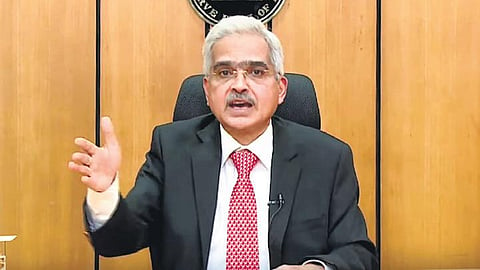Coronavirus: RBI devises Rs 3.47 lakh crore liquidity injection to mitigate lockdown impact
HYDERABAD: As part of its Covid-19 package, the Reserve Bank of India on Friday vowed to pump in Rs 3.74 lakh crore additional liquidity to the system. Together with the liquidity boosting measures undertaken by the central bank after its policy review in February, the injected liquidity now stands at 3.2 per cent of the GDP, said RBI Governor Shaktikanta Das.
RBI has already injected liquidity worth Rs 2.8 lakh crore, or 1.4 per cent of the GDP, through various instruments since February. “Along with today’s measures, the liquidity now equals to 3.2 per cent of GDP. RBI will take continuous measures to ensure liquidity in the system,” Das said.
On Friday, he further announced a fresh Targeted Long-Term Repo Operation (TLTRO) of up to Rs 1 lakh crore. These will be of three-year tenor, bearing a floating interest rate.
“The issue of capital-starved borrowers despite ample systemic liquidity will partly be addressed by the Rs 1 lakh crore of TLTROs, as this money has to be compulsorily lent to investment-grade Non-Convertible Debenturess and Commercial Papers, which have also been provided additional HTM benefit. The mandate of using this window for both primary and secondary market securities at once provides the much-needed money to corporate borrowers as well as investors such as non-banking financial companies and mutual funds in need of liquidity,” said Piyush Baranwal, senior fund manager (fixed income), Yes Asset Management.
Besides, the Cash Reserve Ratio (CRR) — the percentage of deposits banks park with RBI — of all banks is reduced by 100 bps to 3 per cent from 4, with effect from the fortnight beginning March 28 for one year. The move will release Rs 1.37 lakh crore liquidity into the market. The reduction comes after a gap of seven years and is expected to impove banks’ profitability.
Moreover, the RBI decided to reduce the requirement of minimum daily CRR balance maintenance from 90 per cent to 80 per cent, effective from the fortnight beginning March 28. This is a one-time dispensation available up to June 26.
Lastly, the RBI also increased accommodation under the Marginal Standing Facility (MSF) from 2 per cent of the statutory liquidity ratio to 3 per cent with immediate effect. This will be applicable up to June 30 and will comfort banks by allowing them to avail an additional Rs 1.37 lakh crore liquidity under the LAF window. These three measures including TLTRO, CRR and MSF will inject a total liquidity of Rs 3.74 lakh crore into the system.
Das renders debt servicing easier
RBI has issued certain instructions to all commercial banks, cooperative banks, all India financial institutions and NBFCs in a bid to “mitigate the burden of debt servicing brought about by the disruptions on account of the coronavirus pandemic”. Here’s them in a nutshell:
payment RESCHEDULING
- (I) Term loans All mentioned institutions permitted to grant a moratorium of three months on payment of all instalments falling due between March 1, 2020 and May 31, 2020.
- Instalments include: (i) principal and/or interest components (ii) bullet repayments(iii) Equated Monthly Instalments (EMI) (iv) credit card dues.
- Repayment schedule and the residual tenor for such loans to be shifted across the board by three months after the moratorium period.
- Interest, however, will continue to accrue on the outstanding portion of the term loans during the moratorium period.
(II) Working capital facilities
- For working capital facilities sanctioned in the form of cash credit or overdraft, lending institutions are permitted to defer the recovery of interest for period from March 1 to May 31, 2020.
- Accumulated accrued interest shall be recovered immediately after the completion of this period.
EASING OF WORKING CAPITAL FINANCING
- Lending institutions may recalculate the ‘drawing power’ by reducing the margins and/or reassessing the working capital cycle for working capital facilities (CC/OD) sanctioned for borrowers facing stress due to the pandemic.
- This relief shall be available for all such changes made up to May 31, 2020 and shall be contingent on the lenders satisfying themselves that such a move is necessary due to the fallout of the Covid-19 pandemic.
- Accounts provided with such relief will be subject to subsequent supervisory reviews to establish whether such an action was justified.
CLASSIFICATION AS SMAs and NPAs
- Since these reliefs are being provided specifically to help borrowers deal with the fallout of the pandemic, they will not be treated as concessions. Consequently, such a measure, by itself, shall not result in an asset classification downgrade.
- Asset classification of term loans that are granted relief shall be determined on the basis of revised due dates and the revised repayment schedule.
- Similarly, status of working capital facilities where relief is provided shall be decided on the application of accumulated interest immediately after the completion of the deferment period.
- Rescheduling of payments, including interest, will not qualify as a default for the purposes of supervisory reporting and reporting to Credit Information Companies (CICs) by lenders. CIC to ensure such actions do not adversely impact the credit history of beneficiaries.

